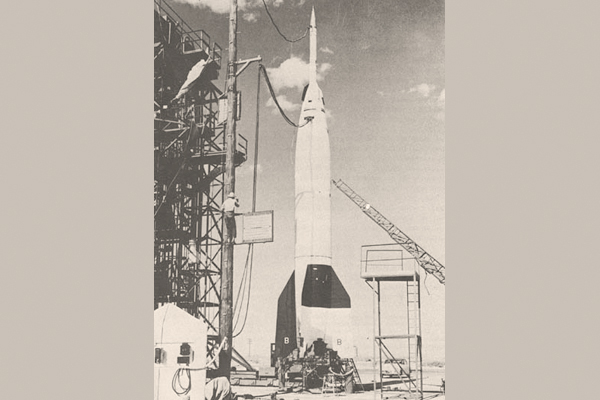|
Missile Range History

V-2 ROCKET AND WAC CORPORAL COMBO: THE BUMPER-WAC AT WHITE SANDS IN THE
LATE 1940S
Photo:
NASA
The following military history article was written by Michael Shinabery.
Mr. Shinabery is an education specialist at the
New Mexico Museum of
Space History.
Two V-2s veer off course, one crashes in Alamo
After two rockets launched during two
weeks from White Sands Proving Grounds crashed near populated areas, the
Army quickly "imposed a stand-down in the
testing," said Wayne Mattson
|
|
in the New Mexico Space Journal (No. 1,
June 2001).
The first crashed May 15, 1947. But
what Mattson called "the most infamous" of the launches crashed
[22 years
ago] on May 29.
"An international incident" nearly
occurred when the V-2 plowed into "a cemetery south of Ciudad Juarez,
Mexico." Following
Hitler's fall in 1945, the
United States brought 177 German rocket scientists and technicians to
White Sands and Fort Bliss under Operation Paperclip. |
Documents in the New Mexico Museum of
Space History archives detail the classified project, and how the
military also sent 300 railroad boxcars crammed with V-2 parts into
southern New Mexico.
At WSPG, the Germans began building the
United States Army's rocket program. Early launches either
blew up on the pad or crashed on base. But when the first V-2 went
ballistic off base, a U.S. senator representing New Mexico called for a
"halt" to V-2 testing, Mattson said.
After the May 15 disaster, the May 22
Alamogordo News reported "the people of Alamogordo got a thrill and
incipiently a scare as some sort of body flew over the town in erratic
flight and exploded at least once before dropping to earth." The rocket
smacked into the Sacramento Mountains' foothills just behind what is now
the
New Mexico Museum of Space History.
The book "We Develop Missiles, Not
Air!" by Mattson and Martyn Tagg, (Air Combat Command,
USAF/Cultural Resources Publication No. 2/June 1995) said the launch
took place at 4:08 p.m. from
Launch Complex 33. The liquid fuel was programmed to burn for 63.6
seconds, and thrust the 9,827-pound rocket to 4,696 feet per second or
3,202 mph, attaining 76 miles in altitude. However,
technicians noted "steering was a trouble from liftoff," and "We Develop
Missiles, Not Air!" said the V-2
"began tumbling end over end through the atmosphere. The pressure broke
the missile apart." Pieces fell near 13th Street and Cuba Avenue, and
along the Southern Pacific Railroad tracks.
The News reported residents "got into
cars and hastened to the vicinity" of the crash above Indian
Wells Road, about 35 miles from LC 33. Citizens also "guarded a
portion of the apparatus the rocket was carrying" that had plummeted
down to First Street.
Bob Callaway, a high school freshman in
1947, said in a 1995 NMMSH oral history that he and a friend were
tossing a ball at Michigan Avenue and 15th Street when the power lines
"started shaking violently. About that time we got the sound wave
from the explosion of the V-2." Callaway and four friends rushed to the
scene in a truck, and watched
personnel load wreckage onto a trailer. He said security permitted them
to take non-hazardous
material, and they carted off a "bonanza" of wiring and steel tanks.
They used the wires to build model
airplanes, and the tanks to make "portable welding units," he said.
Callaway knew of one person who found
cameras. That night "OSI started knocking on doors, and
believe it or not, by midnight had recovered all five cameras," Callaway
said.
An Army release stated the payload was
benign: "scientific equipment" for the Naval Research
Laboratory, "two spectrographs and four 16mm gunsight aiming point
cameras a cosmic ray count
recorder camera and two other aircraft cameras." Also aboard was "a
quantity of rye seed, which will
be tested for effect on fertility of exposure to the upper atmosphere."
What was not in the payload was one of
the V-2's "deadly" warheads, Mattson and Tagg said.
The News printed a follow-up story on
June 17 after the Army towed a V-2 to Alamogordo to show the
community "what nearly hit them," Mattson and Tagg wrote. The paper also
stated Sen. Hatch "has
announced he will recommend to the War Department that experiments at
the White Sands Proving Ground be removed to an uninhabited region 'such
as Bikini Atoll.'"
The May 29 disaster was never listed in
"the official White Sands firing summary," Mattson said in the
New Mexico Space Journal. Launched from LC 33, the rocket was supposed
to fly north, but instead
turned south. "The missile ultimately arced over El Paso and landed"
(impacted) south of Juarez near a
cemetery. "A few hours after the wayward missile landed (impacted), the
U.S. Army showed up and
found that enterprising Mexicans were selling any old piece of scrap
metal they could find and
claiming it was V-2 debris. The United States ultimately apologized to
Mexico for the incident and
paid for all damages incurred."
There is no record the News ever
directly reported on the second incident, but the paper did reference
it in the June 17 article. The story also said the Chamber of Commerce
asked Hatch to "withdraw his
recommendations to the War Department."
Subsequently, V-2 launches "resumed" in
July 1947 "after safety procedures had been developed to
prevent the rockets from endangering civilian populations again,"
Mattson wrote in the Space
Journal.
[End article]
To the best of our knowledge all information is current. If you should
discover any errors, however, please let us know. Thanks!
| 